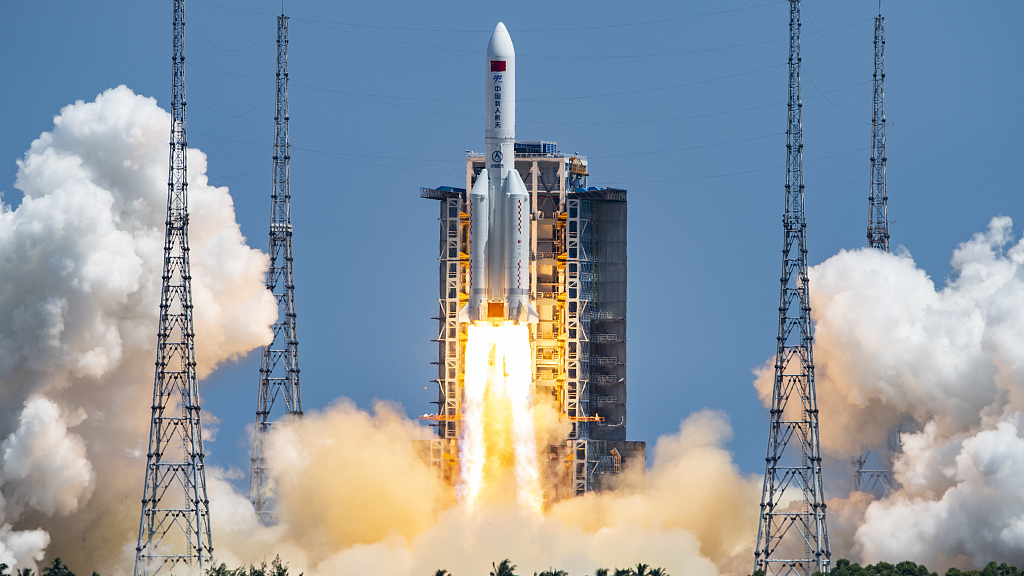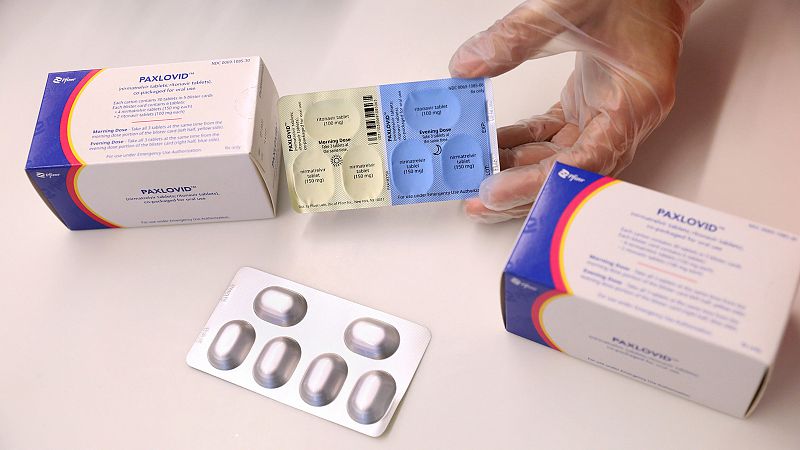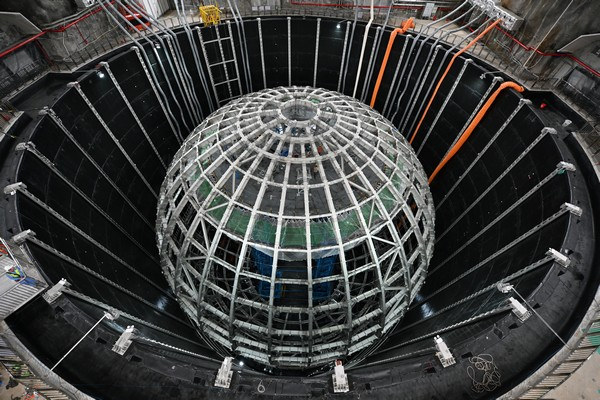
China successfully launches its space station lab module Wentian, the largest spacecraft ever developed by the country, into orbit, July 24, 2022. /CFP
China successfully launches its space station lab module Wentian, the largest spacecraft ever developed by the country, into orbit, July 24, 2022. /CFP
There are a number of big sci-tech events you won't want to miss out on in 2023.
To name few of them, the exploration of the moon will become a hot topic, with various deep space projects on the agenda. Many large scientific facilities will soon be put into operation to help basic research, while COVID-19 vaccine and drug research and development will remain the focus of the global medical community.
Space exploration
China will maintain a high density of launches this year.
China Aerospace Science and Technology Corp, the nation's leading space contractor, said it will arrange more than 50 launches in 2023. Other space enterprises plan to launch about 10 flights.
In addition to the rocket launches, the country will continue with the research and development of the Tianwen-2 asteroid probe and the Chang'e-7 lunar probe.

Image shows China's national flag unfurled from the Chang'e-5 probe on the Moon, December 4, 2020. /China National Space Administration
Image shows China's national flag unfurled from the Chang'e-5 probe on the Moon, December 4, 2020. /China National Space Administration
Other countries will continue to carry on the momentum of space exploration, with the moon being a priority.
Russia plans to launch its Luna-25 moon probe in 2023, which main tasks include testing soft landing technologies and conducting contact studies of the lunar south pole.
Chandrayaan-3, India's third lunar exploration mission, is scheduled to be launched this year after several delays. The country aims to put a lander and rover in the highlands near the south pole of the moon.
Japanese company's HAKUTO-R Mission 1 lunar lander is planning a soft landing on Earth's nearest celestial neighbor in April.
U.S. space agency NASA's small satellite Lunar Flashlight will soon enter into orbit around the moon. It will use near-infrared lasers and an onboard spectrometer to map ice in permanently shadowed regions near the moon's south pole.
Deep space exploration also deserves a mention.
The European Space Agency (ESA)'s Jupiter Icy Moons Explorer, also called JUICE, is scheduled to be launched in April. The goals will focus on Jupiter and its system, with particular emphasis on Ganymede as a planetary body and potential habitat.
NASA continues its Psyche asteroid mission, targeting a launch period opening in October. The agency selected Psyche to investigate a previously unexplored metal-rich asteroid of the same name. The spacecraft will arrive at the asteroid in 2029.
More space observatories are expected to be deployed this year.
Euclid, an ESA medium class astronomy and astrophysics space mission, is expected to make a 3D-map of the universe by observing billions of galaxies out to 10 billion light-years, across more than a third of the sky.
The Japan Aerospace Exploration Agency has developed the X-ray Imaging and Spectroscopy Mission (XRISM), which is scheduled to launch into orbit around Earth in 2023. XRISM will perform high-resolution X-ray spectroscopic observations of the hot gas plasma wind that blows through the galaxies in the universe.

Pfizer's Paxlovid tablets – an oral treatment for COVID-19. /CFP
Pfizer's Paxlovid tablets – an oral treatment for COVID-19. /CFP
Drug development amid COVID-19
This year, COVID-19 vaccine and drug research and development will remain the focus of the global medical community.
More breakthroughs are expected in the research of multivalent vaccines, nasal-spray vaccines and small molecules in targeted therapies, which will further empower humans to fight against COVID-19 and other infectious diseases.
The widespread use of mRNA vaccines during the COVID-19 pandemic has spurred the development of such vaccines for other diseases.
German biotechnology company BioNTech is expected to initiate trials for mRNA vaccines against malaria, tuberculosis and genital herpes.
The company has announced a new research and development collaboration with Pfizer to trial an mRNA-based vaccine candidate to reduce the rate of shingles. U.S. biotechnology company Moderna also has mRNA vaccine candidates for the viruses that cause genital herpes and shingles.
In addition, more new drugs and therapies are expected. On January 6, the U.S. Food and Drug Administration (FDA) approved an Alzheimer's drug, called lecanemab, which can slow the progression of Alzheimer's disease by 27 percent in a larger trial conducted recently.
Exa-cel, a gene-editing therapy for β-Thalassaemia and sickle-cell disease, is expected to be submitted to the FDA this year. If approved, exa-cel would become the first marketed therapy based on the CRISPR gene editing technology.

The plexiglass spherical structure, the core structure for China's next-generation neutrino detector, the Jiangmen Underground Neutrino Observatory (JUNO), in Jiangmen City of south China's Guangdong Province. /China Media Group
The plexiglass spherical structure, the core structure for China's next-generation neutrino detector, the Jiangmen Underground Neutrino Observatory (JUNO), in Jiangmen City of south China's Guangdong Province. /China Media Group
Physics breakthroughs
In recent years, advances in physics have become increasingly dependent on big scientific devices. A number of big science installations will be put to use in 2023, promising to propel new discoveries in physics.
The installation of the underground neutrino observatory in Jiangmen, China, is scheduled to be completed at the end of 2023. One of its main goals is to determine the neutrino mass hierarchy.
The U.S. Linac Coherent Light Source (LCLS) is the world's first hard X-ray free-electron laser. The upgraded LCLS-II will provide a major jump in capability, moving from 120 pulses per second to 1 million pulses per second, which will enable researchers to perform experiments in a wide range of fields that are now impossible.
The Matter-wave laser Interferometric Gravitation Antenna (MIGA) will be put into operation this year. The underground instrument in France will use cold-atom interferometry to perform precision measurements of gravity gradients and strains.
The European Spallation Source is under construction on the outskirts of Lund, a city in southern Sweden. It will start the scientific user program in 2023.

The COP15 logo in Montreal, Quebec, Canada, December 16, 2022. /CFP
The COP15 logo in Montreal, Quebec, Canada, December 16, 2022. /CFP
Ecological conservation
Under the leadership of China, a UN biodiversity deal entitled Kunming-Montreal Global Biodiversity Framework, aimed at reversing biodiversity loss and setting the world on path of recovery, was adopted at 15th meeting of the Conference of the Parties (COP15) to the UN Convention on Biological Diversity (COP15). The deal includes four goals and 23 targets for achievement by 2030.
China will actively guide the implementation of the goals and targets in the framework, and ensure that relevant decisions are fully implemented, said Huang Runqiu, COP15 president and China's minister of ecology and environment.
The frequent occurrence of natural disasters and extreme weather in 2022 further highlights the necessity of harmonious coexistence between man and nature.
The 14th Meeting of the Conference of the Contracting Parties to the Ramsar Convention on Wetlands, the 27th session of the Conference of the Parties (COP27) to the United Nations Framework Convention on Climate Change, and the COP15 were held in the last two months of 2022.
The meetings expanded the consensus of all parties in the fields of protecting the ecological environment, coping with climate change and boosting green transformation, which is significant for promoting the development of global ecological civilization in the coming period. On the basis of the phased results, the parties will continue to promote the follow-up negotiations and the implementation of the results this year.
As a highlight of COP27, the conference finally agreed to establish a "loss and damage" fund to provide financial assistance to the most vulnerable and hardest-hit by climate change.
Participants in COP27 also agreed to establish a "transitional committee" to make recommendations on how to operationalize both the new funding arrangements and the fund at COP28. The first meeting of the "transitional committee" is expected to take place before the end of March 2023.
(With input from Xinhua)